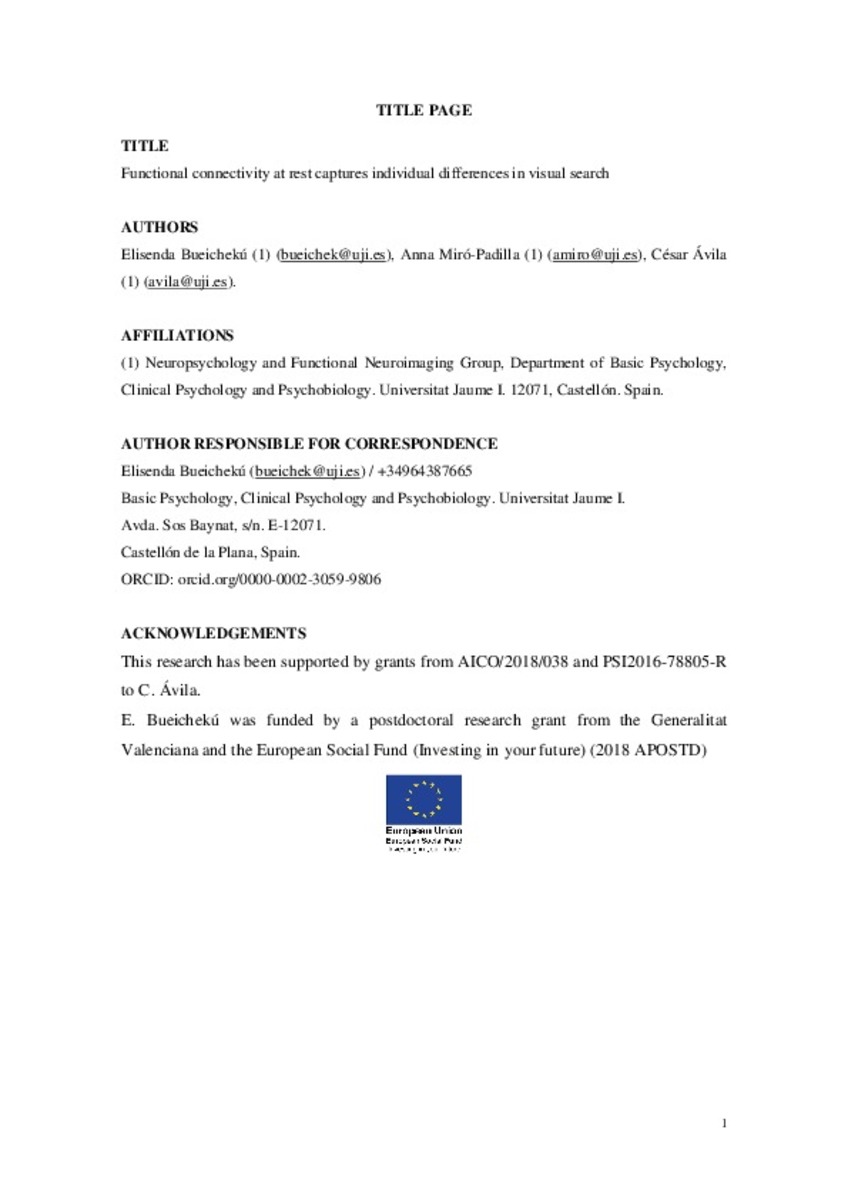| dc.contributor.author | Bueichekú, Elisenda | |
| dc.contributor.author | Miró-Padilla, Anna | |
| dc.contributor.author | Avila, Cesar | |
| dc.date.accessioned | 2020-03-25T08:56:55Z | |
| dc.date.available | 2020-03-25T08:56:55Z | |
| dc.date.issued | 2020-03 | |
| dc.identifier.citation | Bueichekú, E., Miró-Padilla, A. & Ávila, C. Functional connectivity at rest captures individual differences in visual search. Brain Struct Funct 225, 537–549 (2020). https://doi.org/10.1007/s00429-019-02008-2 | ca_CA |
| dc.identifier.issn | 1863-2653 | |
| dc.identifier.issn | 1863-2661 | |
| dc.identifier.uri | http://hdl.handle.net/10234/187092 | |
| dc.description | This is a pre-print of an article published inBrain Structure and Function. The final authenticated version is available online at: https://doi.org/10.1007/s00429-019-02008-2 | |
| dc.description.abstract | Brain functional connectivity is supposed to capture personal and lifetime learning experiences and contribute to generating individual differences in cognitive abilities. We tested this possibility using the visual search task as a measure of visual information processing and the functioning of the visual attention control system. Forty-two undergraduate students completed a functional MRI study with a resting-state session and a visual search task scan. The visual attention and control systems were studied by investigating the functional connectivity of the primary visual area, the posterior parietal cortex, the dorsolateral prefrontal cortex, and the dorsal anterior cingulate cortex because these areas have been closely related to the visual search task. A pairwise resting-state functional connectivity analysis was conducted between these regions, followed by a correlation analysis with the behavioral measures from the visual search task. Results showed that higher connectivity values between the posterior parietal cortex and the dorsal anterior cingulate cortex were positively correlated with faster response speed. The posterior parietal cortex has been related to the formation of priority maps and the integration of sensory and executive information. Inhibitory control, performance monitoring during top–down cognitive tasks, and target detection have been associated with the dorsal anterior cingulate cortex. In light of these results, we suggest that a priori enhanced connectivity between these regions defines individual differences in visual information processing and the ability to adapt to cognitive demands. | ca_CA |
| dc.format.extent | 13 p. | ca_CA |
| dc.format.mimetype | application/pdf | ca_CA |
| dc.language.iso | eng | ca_CA |
| dc.publisher | Springer | ca_CA |
| dc.relation.isPartOf | Brain Structure and Function, 2020, vol. 225, no 2 | ca_CA |
| dc.rights | © Springer Nature | ca_CA |
| dc.rights.uri | http://rightsstatements.org/vocab/InC/1.0/ | * |
| dc.subject | individual differences | ca_CA |
| dc.subject | MRI | ca_CA |
| dc.subject | resting-state functional connectivity | ca_CA |
| dc.subject | visual search task | ca_CA |
| dc.subject | visual attention | ca_CA |
| dc.title | Functional connectivity at rest captures individual differences in visual search | ca_CA |
| dc.type | info:eu-repo/semantics/article | ca_CA |
| dc.identifier.doi | https://doi.org/10.1007/s00429-019-02008-2 | |
| dc.rights.accessRights | info:eu-repo/semantics/openAccess | ca_CA |
| dc.relation.publisherVersion | https://link.springer.com/article/10.1007/s00429-019-02008-2 | ca_CA |
| dc.contributor.funder | This research has been supported by Grants from AICO/2018/038 and PSI2016-78805-R to C. Ávila. E. Bueichekú was funded by a postdoctoral research grant from the Generalitat Valenciana and the European Social Fund (Investing in your future) (2018 APOSTD) | ca_CA |
| dc.type.version | info:eu-repo/semantics/submittedVersion | ca_CA |







